TOPICS
Jan 7, 2024
- NEWS
- Others
Interviews were conducted with Hiroshi Nishino (IGHD), Yutaka Amao (ReCAP) and Shigeyuki Minami (ReCAP).
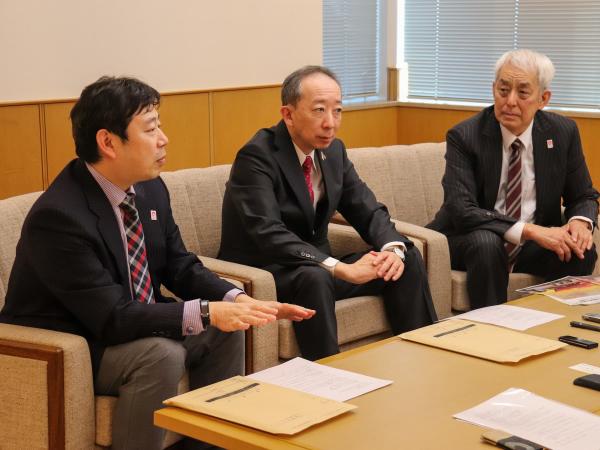
Osaka Metropolitan University and Iida Group Holdings (Iida GHD) will jointly exhibit at the 2025 World Expo in Osaka, Kansai. Iida GHD, committed to developing sustainable homes that provide long-term comfort and health, has established joint research divisions with our university's Research Center for Artificial Photosynthesis and Center for Health Science Innovation. The results of this collaboration will be showcased at the Expo, including the IG Perfect Eco House equipped with artificial photosynthesis technology and the Wellness Smart House that utilizes AI for health management.
We had the honor of interviewing Mr. Hiroshi Nishino, Executive Vice President of Iida GHD, along with Dr. Yutaka Amao, Director of the Research Center for Artificial Photosynthesis, and Professor Shigeyuki Minami, Specially Appointed Professor at the same center. The interview focused on the circumstances leading to the Expo exhibition and the research on artificial photosynthesis.
How will housing and urban environments evolve in the near future?
What is the core message you aim to convey through the Iida Group and Osaka Metropolitan University joint pavilion at the World Expo?
Hiroshi Nishino, Executive Vice President (hereafter referred to as Nishino)
The theme of the Expo is "Designing a Future Society where Life Shines." However, the seeds of the future are sown in the past. We're considering expressing the concept of technology evolving through a cycle of reincarnation, inheriting traditions and progressing from the past to the future, through both the exterior design and the exhibits within the pavilion. Therefore, we have decided to use Nishijin-ori, a traditional Kyoto textile with over 1200 years of history, for the exterior, and to design a unique structure based on the Möbius strip motif.
Within the pavilion, we will showcase artificial photosynthesis technology developed in collaboration with the Research Center for Artificial Photosynthesis, and a wellness smart house developed jointly with theCenter for Health Science Innovation. Regarding the artificial photosynthesis house, we will introduce technologies that minimize environmental impact, such as utilizing artificial photosynthesis powered by solar energy to supply the house with energy, and generating energy by breaking down natural materials using sunlight. Regarding the wellness smart house, we plan to showcase a portion of the technology that collects and AI-analyzes resident health data throughout the entire house, offering visitors a firsthand experience of the future health homes that can contribute to extending healthy lifespan. Additionally, we would like visitors to experience the vision of a future city through models and videos, and we invite students of the next generation to showcase their own visions of the future.
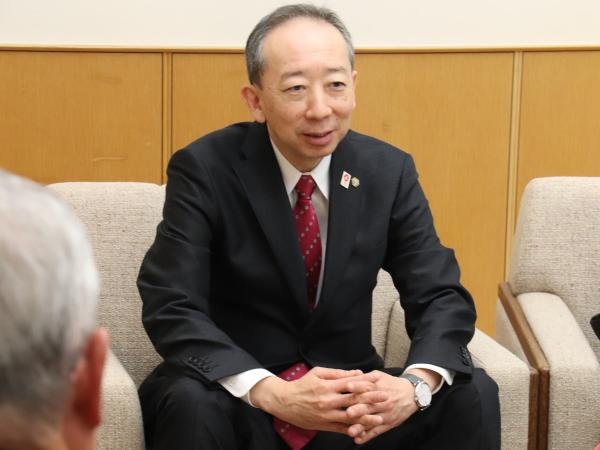
Artificial photosynthesis makes self-sufficient energy production possible.
Could you please tell me more about artificial photosynthesis houses?
Shigeyuki Minami, Specially Appointed Professor (hereafter referred to as Minami)
The ultimate objective of artificial photosynthesis is to ensure the continued advancement of human civilization and the well-being of all people. In contrast to fossil fuels, which are finite and geographically restricted, solar energy is an inexhaustible resource that is ubiquitously available on Earth. It is estimated that the annual solar energy incident on Earth is more than 100 times the total reserves of all fossil fuels. Artificial photosynthesis houses aspire to harness this immense energy source directly to meet the energy needs of individual households. The successful implementation of this technology holds the promise of global benefits.
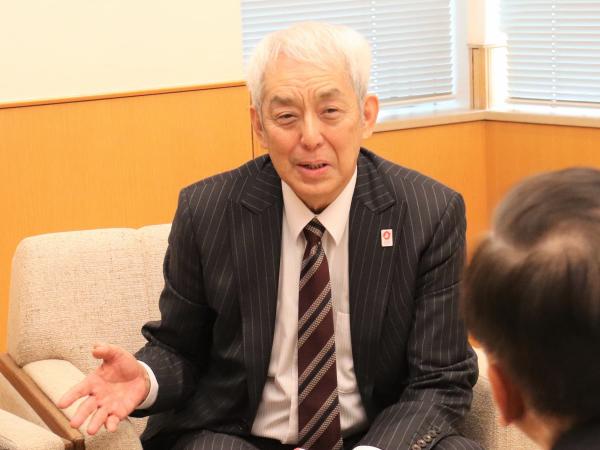
Yutaka Amao, Director (hereafter referred to as Amao)
An artificial photosynthesis house generates formic acid from CO2 through solar-driven artificial photosynthesis. The hydrogen produced from the formic acid is subsequently used to generate electricity. By capturing and recirculating the CO2 emitted during hydrogen production back into the artificial photosynthesis process for formic acid generation, the house effectively achieves net-zero CO2 emissions. Historically, the production of substances from CO2 has been hindered by the inevitable residual carbon. By recycling this carbon as CO2, we can attain genuine carbon neutrality. I am convinced that artificial photosynthesis is the pathway to this end.
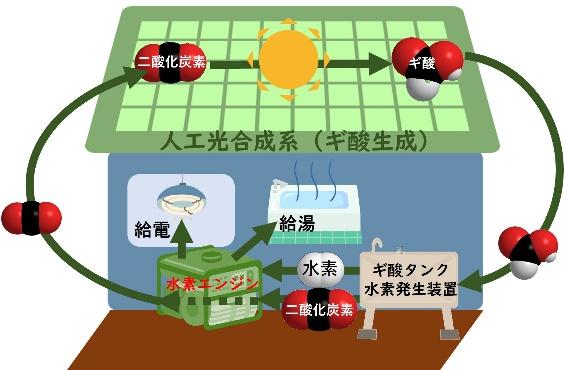
What is artificial photosynthesis, exactly?
Amao One definition of artificial photosynthesis is a process that utilizes light energy to split water into hydrogen or to produce useful substances using CO2 as a raw material.
Natural photosynthesis is a process where plants use sunlight to convert CO2 and water into starch, glucose, and oxygen. While natural photosynthesis produces starch and glucose, the appeal of artificial photosynthesis lies in its ability to produce a wide variety of substances from CO2. For example, in addition to formic acid mentioned earlier, it can produce carbon monoxide, methanol, and even raw materials for plastics. However, due to this diversity, determining the ultimate goal can be challenging.
Formic acid is the easiest substance to produce from CO2 using artificial photosynthesis, and I was originally involved in research focused on producing formic acid from CO2. While many people express their amazement at the ability to create substances from CO2, I've been considering what comes after that "wow" factor. After much thought, I've decided to make utilizing formic acid as the next energy source one of the pillars of this project. I believe that being able to utilize CO2 is one of the primary objectives of artificial photosynthesis.
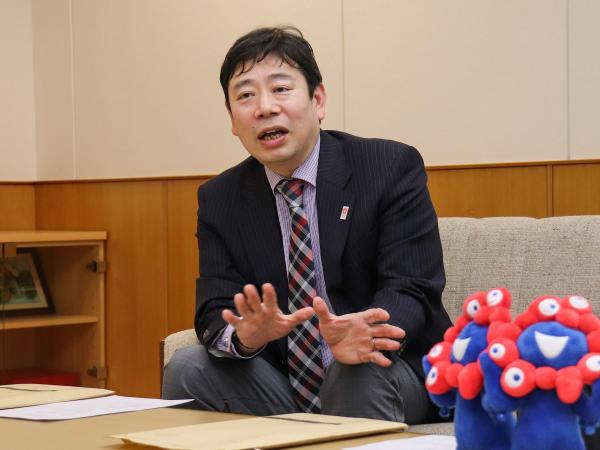
Collaboration with other fields and companies can create new possibilities.
Could you please tell me about the circumstances that led to your company's participation in the Osaka-Kansai Expo?
Minami IGHD and our university have been conducting various joint research projects for over 20 years. One example is our participation in the Osaka Pavilion at the 2010 Shanghai Expo, where we exhibited an artificial aurora generator. At that time, I was affiliated with the Faculty of Engineering, but I transferred to the Artificial Photosynthesis Research Center in 2012. There, I sensed new possibilities for joint research suitable for artificial photosynthesis. If we can develop devices that use artificial photosynthesis to produce hydrogen and convert it into energy, and equip each house with these devices, we can realize self-sufficient energy-generating homes.
When I discussed these ideas with IGHD, they were very supportive of our idea, and as a result, we launched a large-scale joint research project in 2015, working together with Professor Amao, the director of the center. During this collaboration, our university proposed the idea of jointly exhibiting at the Osaka-Kansai Expo to showcase the results of our joint research, and Mr. Iida graciously accepted our proposal.
Nishino I believe it was a stroke of luck that the theme of the Expo aligned so perfectly with our joint research on the future of living. Thanks to Osaka Metropolitan University's reputation, I think we were fortunate to be approved to exhibit.
IGHD is recognized as Japan's number one share company for detached houses. However, we believe that it is essential to build houses with not only a large quantity but also high basic quality. Therefore, we supply houses that have achieved the highest ratings in all major items of the housing performance evaluation established by the Ministry of Land, Infrastructure, Transport and Tourism, such as earthquake resistance and thermal environment. Not only should houses be kind to people, but also the towns where we live should be environmentally friendly. If we can realize a system in homes that minimizes the use of fossil fuels, it would be extremely valuable. This desire led me to Professor Amao, who has been conducting research on artificial photosynthesis, through my connection with Professor Minami. I am grateful for the smooth progress of this project.
Amao When we decided to exhibit at the Expo, my first thought was, "Can we make it in time?" My heart almost stopped. It is very rare for basic research to lead to a demonstration test, so showcasing our empirical research results at the Expo is a huge deal for us researchers. IGHD employees have even come to our university to conduct experiments, enabling us to engage in substantial industry-academia collaboration.
Actually, most of what are called demonstration tests in the world are simply scaled-up versions of existing technologies. Even in demonstration tests that have successfully generated large amounts of hydrogen, I believe that the produced hydrogen was not effectively utilized. Thanks to our collaboration with Professor Minami, an expert in electrical engineering, we have been able to envision processes such as using the generated hydrogen as a power source or capturing CO2. It is significant that we have been able to move from the research stage to a point where realization is possible. I believe this is probably the first fundamental demonstration test of artificial photosynthesis.
Nishino The success of this joint research is due to the integration of Professor Amao's field of chemistry and Professor Minami's field of electrical engineering into a single system. As an outsider, I believe that the key to our success was the ability of each field to collaborate towards a common goal, which would have been difficult to achieve through basic research alone.
Minami Absolutely. This joint research should be pursued with a high aspiration to realize practical applications of artificial photosynthesis. I believe that conducting a thorough demonstration together with a company holds significant meaning.
Finally, could you please share your thoughts on this project and a message for the students?
Minami I want you all to know that a major project like this is already underway at Osaka Metropolitan University, which was established just in 2022. As Executive Vice President Nishino mentioned earlier, this Expo offers an opportunity for students to participate. This is a once-in-a-lifetime chance, so I hope you will all take part and contribute.
Amao While a significant portion of university research is fundamental in nature, I hope you can envision how these basic studies can evolve into something that benefits society. This technology extends far beyond the Expo, reaching into the distant future. For instance, the Paris Agreement aims to reduce carbon emissions by 2050. I hope that looking back from 2050, you will think, "The technology I saw back then has become a reality."
Nishino I hope you understand that good intentions lead to good connections. Your sincere desire to create a sustainable society and extend healthy lifespans has led us to unexpected opportunities such as joint research and Expo participation.
Furthermore, it is because of the unwavering support of our stakeholders since the days of Osaka City University and Osaka Prefecture University that we have been able to build such a wonderful organization and have the opportunity to meet all of you and connect with the Expo. Thanks to the traditions cultivated by all of you, we have been able to create this opportunity, which is now being passed on to our current students. I believe that the Expo is one of the most symbolic events of this. Above all, it is unprecedented in Japan for a university and a company to jointly exhibit a pavilion at the Expo. The fact that Osaka Metropolitan University has achieved this is something I hope many students and alumni will visit the Expo, see the pavilion bearing their university's name, and feel proud of.
I believe that joint research creates a chemical reaction between both parties. For example, companies tend to have a more business-oriented mindset, which can sometimes limit their thinking. However, the unique perspectives and ideas of researchers can be very stimulating. By combining business thinking with academic research, we can create something truly innovative. If we can showcase the results of this project at the Expo, it will not only enhance Osaka Metropolitan University's brand value but also motivate us as a company to fulfill our responsibilities.
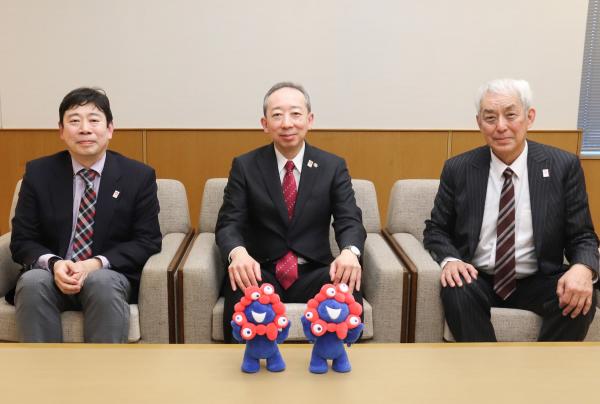
Profile
Hiroshi Nishino (Executive Vice President,Iida Group Holdings Co., Ltd.)
Joined Recruit in 1988. Joined Toei Housing (currently a subsidiary of Iida Group Holdings) in 2006. Became the Representative Director and President of the company in 2007. Became a director of Iida Group Holdings in 2013. Became a Managing Director in 2019 and a Senior Managing Director in 2021. Current position since March 2022.
Yutaka Amao (Director, Research Center for Artificial Photosynthesis)
Doctor of Engineering. Graduated from the graduate school of Tokyo Institute of Technology in 1997. The areas of expertise include nanotechnology, materials science, green and sustainable chemistry, and environmental chemistry. After serving as a researcher at the National Aerospace Laboratory of Japan (currently JAXA) and as an associate professor at Oita University, joined the Research Center for Artificial Photosynthesis in 2013. Became the director in 2015.
Shigeyuki Minami (Specially Appointed Professor, Research Center for Artificial Photosynthesis)
Doctor of Engineering. Graduated from the Graduate School of Engineering at Osaka City University (now Osaka Metropolitan University) in 1972. The areas of expertise include manufacturing technologies (mechanical, electrical, and chemical engineering), power engineering, and planetary science. Exhibited an artificial aurora generator at the Osaka Pavilion of the 2010 Shanghai World Expo. A groundbreaking hydrogen-powered propulsion system was realized for the first time globally in 2019.
Article source: Osaka Metropolitan University ✕ Expo 2025 Osaka-Kansai